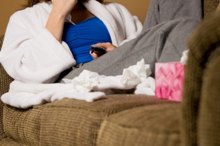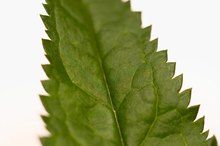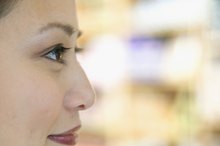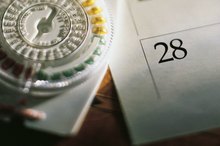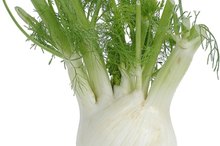What does fact checked mean?
At Healthfully, we strive to deliver objective content that is accurate and up-to-date. Our team periodically reviews articles in order to ensure content quality. The sources cited below consist of evidence from peer-reviewed journals, prominent medical organizations, academic associations, and government data.
- Hong Kong Medical Journal: The Medicinal Action of Androgens and Green Tea Epigallocatechin Gallate
- Hong Kong Medical Journal: The Medicinal Action of Androgens and Green Tea Epigallocatechin Gallate
The information contained on this site is for informational purposes only, and should not be used as a substitute for the advice of a professional health care provider. Please check with the appropriate physician regarding health questions and concerns. Although we strive to deliver accurate and up-to-date information, no guarantee to that effect is made.
Will Drinking Green Tea Lower Androgen in Women?
Both men and women produce androgen, the dominant male hormone, but in differing amounts. Women with polycystic ovary syndrome, or PCOS, often have high androgen levels. High androgen levels in PCOS can increase your risk of developing diabetes and heart disease and cause increased hairiness, acne, abdominal weight gain and male-pattern hair loss. Green tea might have some benefit in lowering high androgen levels, although this has not been conclusively proven. Talk to your doctor before making significant dietary changes.
Green Tea Ingredients
Green tea, made from the unfermented leaves of the Camellia sinesis plant, contains a number of potentially potent substances. Black tea and green tea both contain polyphenols, antioxidants that help prevent cellular damage by removing free radicals, unpaired electrons that damage cell DNA. Green tea contains higher levels of polyphenols. Epigallocatechin gallate, also known as EGCG, might affect androgen levels 3.
- Green tea, made from the unfermented leaves of the Camellia sinesis plant, contains a number of potentially potent substances.
Androgens in Women
Why Is Lifting Weights Causing Acne?
Learn More
Both men and women produce hormones considered as predominantly male or female, such as estrogen or testosterone, the dominant androgen produced by men. Your ovaries and adrenal glands produce most of the testosterone in your body; tumors of the adrenal gland and polycystic ovary syndrome are the most common causes of androgen excess in women. Androgen causes abnormal hair-growth patterns, virilization of female sex organs -- when male characteristics become prominent in a female -- and accumulation of abdominal fat that can lead to metabolic syndrome. Diabetes, obesity, high cholesterol and high blood pressure often occur with metabolic syndrome. Androgen excess is the leading cause of infertility from anovulation -- a condition in which your ovary does not release an egg -- according to an article in the September 2000 issue of "American Family Physician. 2"
- Both men and women produce hormones considered as predominantly male or female, such as estrogen or testosterone, the dominant androgen produced by men.
- Your ovaries and adrenal glands produce most of the testosterone in your body; tumors of the adrenal gland and polycystic ovary syndrome are the most common causes of androgen excess in women.
Studies
Studies on the effects of green tea and androgen levels have mostly looked at the risk of hormone-dependent tumors. An article published in the December 2001 issue of the "Hong Kong Medical Journal" states that epigallocatechin-3-gallate can modulate the production and effects of androgens and other hormones 3.
Considerations
Herbal Testosterone Blocker
Learn More
Laboratory and animal studies don't always translate into human benefits. The amounts of epigallocatechin-3-gallate in green tea might not be significant enough to have noticeable health benefits against high androgen levels 3. While green tea probably won't hurt and could possibly help, see your doctor for proven treatments for high androgen levels, such as birth control pills or weight loss and exercise.
- Laboratory and animal studies don't always translate into human benefits.
- While green tea probably won't hurt and could possibly help, see your doctor for proven treatments for high androgen levels, such as birth control pills or weight loss and exercise.
Related Articles
References
- University of Maryland Medical Center: Green Tea
- American Family Physician: Polycystic Ovary Syndrome: It's Not Just Infertility
- Hong Kong Medical Journal: The Medicinal Action of Androgens and Green Tea Epigallocatechin Gallate
- Bani Mohammad M, Majdi Seghinsara A. Polycystic Ovary Syndrome (PCOS), Diagnostic Criteria, and AMH. Asian Pac J Cancer Prev. 2017;18(1):17–21. Published 2017 Jan 1. doi:10.22034/APJCP.2017.18.1.17
- Antoniou-Tsigkos A, Zapanti E, Ghizzoni L, et al. Adrenal androgens. Endotext. Updated January 5, 2019.
- Horstman AM, Dillon EL, Urban RJ, Sheffield-Moore M. The role of androgens and estrogens on healthy aging and longevity. J Gerontol A Biol Sci Med Sci. 2012;67(11):1140–1152. doi:10.1093/gerona/gls068
- Pasquali R, Zanotti L, Fanelli F, et al. Defining Hyperandrogenism in Women With Polycystic Ovary Syndrome: A Challenging Perspective. J Clin Endocrinol Metab. 2016;101(5):2013-22.
- Rosenfield RL, Ehrmann DA. The Pathogenesis of Polycystic Ovary Syndrome (PCOS): The Hypothesis of PCOS as Functional Ovarian Hyperandrogenism Revisited. Endocr Rev. 2016;37(5):467–520. doi:10.1210/er.2015-1104
- Rosenfield RL. The Polycystic Ovary Morphology-Polycystic Ovary Syndrome Spectrum. J Pediatr Adolesc Gynecol. 2015;28(6):412–419. doi:10.1016/j.jpag.2014.07.016
- Yildiz BO, Bolour S, Woods K, Moore A, Azziz R. Visually scoring hirsutism. Hum Reprod Update. 2010;16(1):51–64. doi:10.1093/humupd/dmp024
- Held BL, Nader S, Rodriguez-rigau LJ, Smith KD, Steinberger E. Acne and hyperandrogenism. J Am Acad Dermatol. 1984;10(2 Pt 1):223-6.
- Shum KW, Cullen DR, Messenger AG. Hair loss in women with hyperandrogenism: four cases responding to finasteride. J Am Acad Dermatol. 2002;47(5):733-9.
- Yildiz BO. Diagnosis of hyperandrogenism: clinical criteria. Best Pract Res Clin Endocrinol Metab. 2006;20(2):167-76.
- Stanczyk FZ. Diagnosis of hyperandrogenism: biochemical criteria. Best Pract Res Clin Endocrinol Metab. 2006;20(2):177-91.
- Azziz R, Carmina E, Dewailly D, et al. The Androgen Excess and PCOS Society criteria for the polycystic ovary syndrome: the complete task force report. Fertil Steril. 2009;91(2):456-88.
- Wang R, Mol BW. The Rotterdam criteria for polycystic ovary syndrome: evidence-based criteria?. Hum Reprod. 2017;32(2):261-264.
- McCartney CR, Marshall JC. CLINICAL PRACTICE. Polycystic Ovary Syndrome. N Engl J Med. 2016;375(1):54–64. doi:10.1056/NEJMcp1514916
- Sheehan MT. Polycystic ovarian syndrome: diagnosis and management. Clin Med Res. 2004;2(1):13–27. doi:10.3121/cmr.2.1.13
- New M, Yau M, Lekarev O, et al. Congenital Adrenal Hyperplasia. [Updated 2017 Mar 15]. In: Feingold KR, Anawalt B, Boyce A, et al., editors. Endotext [Internet]. South Dartmouth (MA): MDText.com, Inc.; 2000-. Available from: https://www.ncbi.nlm.nih.gov/books/NBK278953/
- Kairys N, Schwell A. Cushing Disease. [Updated 2019 May 5]. In: StatPearls [Internet]. Treasure Island (FL): StatPearls Publishing; 2019 Jan-. Available from: https://www.ncbi.nlm.nih.gov/books/NBK448184/
- Allen MJ, Sharma S. Physiology, Adrenocorticotropic Hormone (ACTH) [Updated 2019 Mar 3]. In: StatPearls [Internet]. Treasure Island (FL): StatPearls Publishing; 2019 Jan-. Available from: https://www.ncbi.nlm.nih.gov/books/NBK500031/
- Blouin K, Boivin A, Tchernof A. Androgens and body fat distribution. J Steroid Biochem Mol Biol. 2008;108(3-5):272-80.
- Sam S. Obesity and Polycystic Ovary Syndrome. Obes Manag. 2007;3(2):69–73. doi:10.1089/obe.2007.0019
- Diamanti-Kandarakis E, Dunaif A. Insulin resistance and the polycystic ovary syndrome revisited: an update on mechanisms and implications. Endocr Rev. 2012;33(6):981–1030. doi:10.1210/er.2011-1034
- Corbould A. Effects of androgens on insulin action in women: is androgen excess a component of female metabolic syndrome?. Diabetes Metab Res Rev. 2008;24(7):520-32.
- Dokras A. Cardiovascular disease risk factors in polycystic ovary syndrome. Semin Reprod Med. 2008;26(1):39-44.
- Mueck AO. Treatment of hyperandrogenism in women with ethinylestradiol and cyproteroneacetate. Eur J Contracept Reprod Health Care. 2017;22(3):170-171.
- de Melo AS, Dos Reis RM, Ferriani RA, Vieira CS. Hormonal contraception in women with polycystic ovary syndrome: choices, challenges, and noncontraceptive benefits. Open Access J Contracept. 2017;8:13–23. Published 2017 Feb 2. doi:10.2147/OAJC.S85543
- Reismann P, Likó I, Igaz P, Patócs A, Rácz K. Pharmacological options for treatment of hyperandrogenic disorders. Mini Rev Med Chem. 2009;9(9):1113-26.
- Karakurt F, Sahin I, Güler S, et al. Comparison of the clinical efficacy of flutamide and spironolactone plus ethinyloestradiol/cyproterone acetate in the treatment of hirsutism: a randomised controlled study. Adv Ther. 2008;25(4):321-8.
- Kolodziejczyk B, Duleba AJ, Spaczynski RZ, Pawelczyk L. Metformin therapy decreases hyperandrogenism and hyperinsulinemia in women with polycystic ovary syndrome. Fertil Steril. 2000;73(6):1149-54.
- Sachdeva S. Hirsutism: evaluation and treatment. Indian J Dermatol. 2010;55(1):3–7. doi:10.4103/0019-5154.60342
- Chuan SS, Chang RJ. Polycystic ovary syndrome and acne. Skin Therapy Lett. 2010;15(10):1-4.
- Brady C, Mousa SS, Mousa SA. Polycystic ovary syndrome and its impact on women's quality of life: More than just an endocrine disorder. Drug Healthc Patient Saf. 2009;1:9–15. doi:10.2147/dhps.s4388
- Badawy A1, Elnashar A. “Treatment options for polycystic ovary syndrome.” Int J Womens Health. 2011 Feb 8;3:25-35. doi: 10.2147/IJWH.S11304.
- Alpañés, Macarena; Fernández-Durán, Elena; Escobar-Morreale, Héctor F. Androgens and Polycystic Ovary Syndrome. https://www.medscape.org/viewarticle/754292
- Armeni E1, Lambrinoudaki I2. “Androgens and cardiovascular disease in women and men.” Maturitas. 2017 Oct;104:54-72. doi: 10.1016/j.maturitas.2017.07.010. Epub 2017 Jul 29.
- Karrer-Voegeli S1, Rey F, Reymond MJ, Meuwly JY, Gaillard RC, Gomez F. “Androgen dependence of hirsutism, acne, and alopecia in women: retrospective analysis of 228 patients investigated for hyperandrogenism.” Medicine (Baltimore). 2009 Jan;88(1):32-45. doi: 10.1097/md.0b013e3181946a2c.
- Simon, James. Androgen. HealthyWomen.org. http://www.healthywomen.org/condition/androgen
Writer Bio
A registered nurse with more than 25 years of experience in oncology, labor/delivery, neonatal intensive care, infertility and ophthalmology, Sharon Perkins has also coauthored and edited numerous health books for the Wiley "Dummies" series. Perkins also has extensive experience working in home health with medically fragile pediatric patients.

